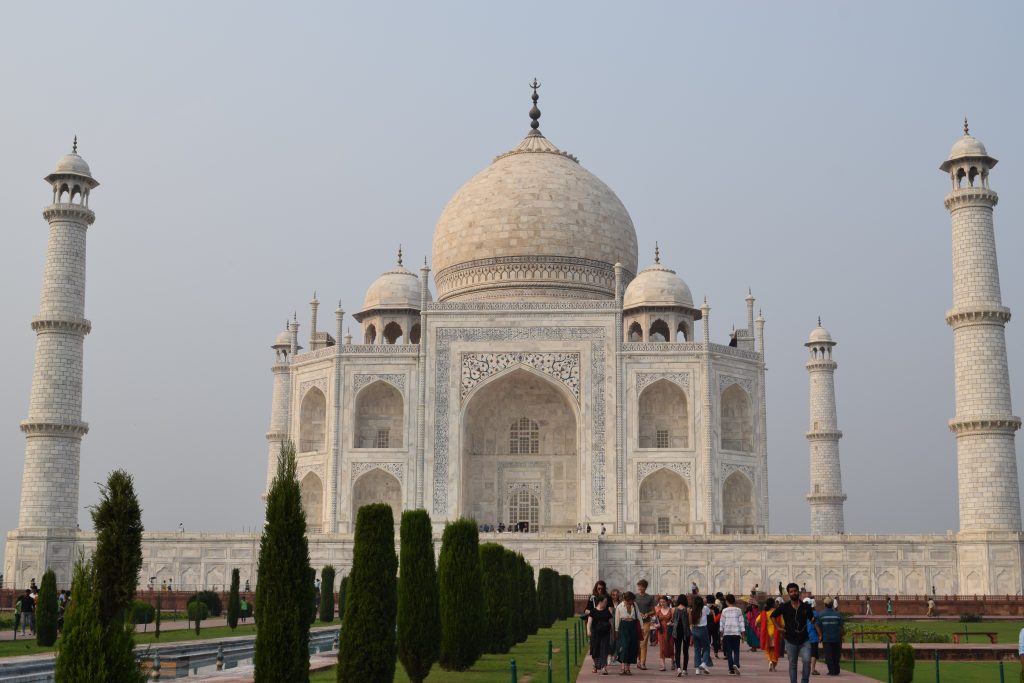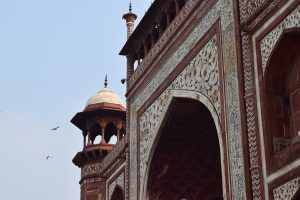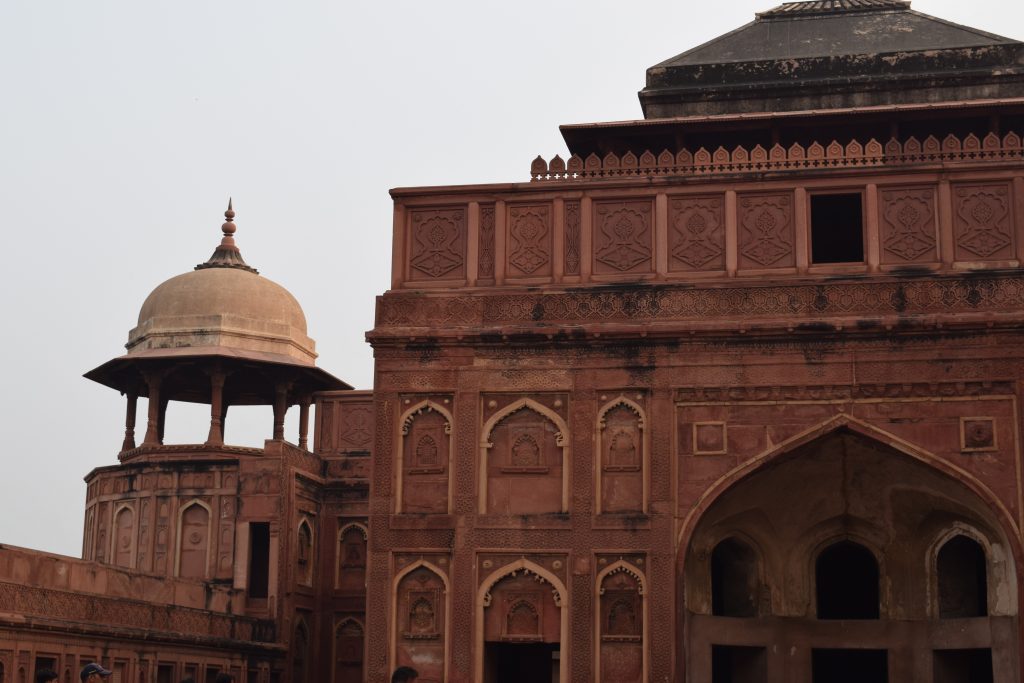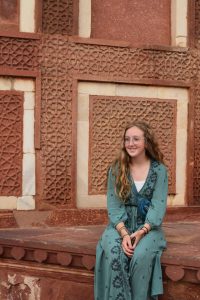The Jewels of India
Similar to our start in Paris and Egypt, our schedule was super packed in India! We saw a lot of amazing architectural structures, sites, temples, and had mind-blowing experiences, and ate more food than we had consumed since Global Semester started!
A conversation between Brendog Beloved Brink and myself at 4:24 pm in Agra.
– Brendog, what was your favourite thing about today so far?
– The Taj Mahal, of course!
– What did you like about it?
– The way it looks and the way it makes my eyeballs feel.

Brendog’s eyes were not exceptional – all of our eyes were melting because of the amount of astonishing beauty that the Taj Mahal offers to its visitors. It would be a crime to be so close to the Taj Mahal and to not visit this world-renowned architectural masterpiece. The whole monument is made from pure white marble that was carried to Agra by ten thousand elephants. The marble is not porous – all the detailed patterns we saw are actually cavities filled with semiprecious stones. Taj Mahal’s story of love and beauty goes beyond horizons – people might not know much about India, but the chances are very high that they have heard of Taj Mahal or seen a picture of it. In the 17th century, the Fifth Mughal King, Shah Jahan, built this magnificent monument in memory of his beloved wife, Mumtaz Mahal who passed away after giving birth to their 14th child. When she fell sick, she asked Shah Jahan, “What would you do for me if I die?” Shah answered that he would build a gorgeous palace that will stand for a long time, so everyone who ever comes to visit will know about the story of their inseparable love. The tombs of Shah Jahan and Mumtaz Mahal are inside the building, continuously telling the story of their love, inviting people to India, and letting romantics dream of their love stories. Before we entered the main dome building, Aml, our own Egyptian Queen ‘21 said, “I wish I had someone to build Taj Mahal for me!” Would you want a Taj Mahal for yourself?

Our next stop was the Agra Fort, yet another marvelous architectural and historical sight that welcomes many travelers both from India and abroad every day. I think most of you who are reading this blog post have been to St Olaf and have noticed our cute community members – squirrels-all around campus. When I first came to St Olaf from Armenia, where during my entire 18 years of existence I had only seen one squirrel, I was pretty excited to see cute little creatures who somehow survive our crazy winters in Minnesota. My excitement to see them would always give me away as a foreigner because none of the Minnesotans seemed to be excited to see them. I am telling this story because we had the reverse story in Agra fort where all the travelers, including us, were entertained by the monkeys that looked like they owned the Red Fort. The quote of the day is about those monkeys,
“If I was a monkey, I would for sure be in this fort” (Ryan Torbenson, ‘20).
Agra Fort was built by the Third Mughal King, Jalal-ud-din Muhammad Akbar the grandfather of Shah Jahan, who built the Taj Mahal. In the center of the complex was the Anguri Bagh, which means Grapes Garden, that was the source of wine they would make. The complex was rich with its detailed engravings that to me were the jewels of the fort. Maybe Ryan’s desire was also driven by his fascination of the beautiful wall sculptures that cost a little too much to make. The Mughal King ordered to chop the thumbs of the artists so that they couldn’t make this art anywhere else in the world.

India was also wonderful because of the FOOD, GLORIOUS FOOD everywhere we went! I can’t even describe the taste; you have to go and try for yourself basmati rice, butter chicken, paneer veggies, pani puri and more and more and more. Speaking of food, since the day we arrived in India, I think half of the group has tried to challenge themselves with testing their spice tolerance. One of the days, the competition and the thrill went beyond craziness when Isaac Leer almost earned 125 dollars if he ate a chilli pepper without flinching. Instead, our 11 years old Silas, jumped in and munched on the entire chili pepper! It took him three seconds until he started bawling the Nile River from his eyes! He was both laughing and crying at the same time. The spectators were confused, worried, but truth be told laughing as well. He kept drinking water and eating ice cream to soothe the burn. He is sitting right next to me at the moment, (the next day) our proud resilient trooper, who nevertheless persisted and achieved victory over the Chili Kingdom.

Our last day was the busiest and felt like an entire week by itself because of the number of things we did. We went to Old Delhi; the third largest mosque in the world, Jama Masjid; then had a rickshaw bicycle ride; went to Mahatma Gandhi’s memorial; Humayun’s tomb; and Qutub Minar tower with Hindu-Islamic architecture motifs.
I want to highlight our visit to Jama Masjid mosque for its beauty and intrinsic spiritual value that it carries. Once you enter you are given a long robe to cover up your open skin, for both men and women – then you enter the big open area fenced with beautifully carved walls that are high enough to separate the mosque from the streets but are short enough to feel connected with Old Delhi. Once we entered the mosque courtyard my eyes were drawn to Jama Masjid’s three large domes in between two very tall minarets where Imams make the calls for prayer. It was fascinating to feel the spiritual energy of this holy place even while being foreign to Islam. Claire Walsh ‘21 and I were sitting on the floor inside the mosque watching people, the surroundings, trying to soak it all in. Claire said, “My heartbeat slows down here. I feel at peace.“
Birds hovered over the minarets of the mosque, pilgrims rested their heads on their backpacks on the cornerstones of the area, and Muslims prayed with their palms open towards the ceiling of the mosque. In addition to those peaceful and harmonious activities, a bunch of tourists, neglecting the signs not to enter the worshipping areas, still stepped on the carpet inside – I guess feeling they have the right and privilege to take pictures with the statues and the walls of the mosque, disrespecting the harmony and the spirit of the mosque.
One last story that happened to some of us on our first day of arrival in Delhi it left its footprint in my heart. A seven or eight years old little girl was dancing right next to our car, doing circus tricks – moving her entire body through an oval metal piece. After doing the tricks five or six times, she kept tapping on the window and asking for money gesturing to her mouth with her fingers. She looked experienced and looked like she has been doing this for a while. Her hair was braided in two braids. She was wearing a tee shirt and a beautiful Indian skirt with leggings under it. Although she was carrying the dust of the streets of Delhi, it looked like she was intentionally made to look neat and nice. I took the initiative of encouraging the people in the car not to give her money and instead cookies or food if they had it, as I heard from many of my friends who are from India or lived there that many children are put to work as beggars. They don’t actually get to keep the money they “make” but rather give it their bosses. Of course, I made a whole range of assumptions about the situation we were in and thought it’s best not to promote any possible child labour. However, I am sure it is always more complex than that. I am thinking what if I was that girl and decided to show what I am good at to get some money for my family? I would not like to be pitied or looked down upon. I don’t have an answer but rather I am left with even more questions, inner conflict and frustration of how divided our world is.
“I will give you a Talisman. Whenever you are in doubt, or when the self becomes too much with you, apply the following test.
Recall the face of the poorest and the weakest man whom you may have seen, and ask yourself, if the step you contemplate is going to be of any use to him.
Will he gain anything by it? Will it restore him to control over his own life and destiny?
In other words, will it lead to swaraj [freedom] for the hungry and spiritually starving millions?
Then you will find your doubts and your self melt away.”
– Mahatma Gandhi, the Father of the Indian Nation
One’s worry at St Olaf can be, “I got a C in my test” versus the girl next to our car who was disappointed that none of us gave any money to her. The sons of one of our night guards from Tanzania, Loishiye, almost dropped out of school because he did not have 76 US dollars to pay for the entire year of tuition at a local school–in contrast to 60,000 US dollars tuition that one pays to go to St. Olaf or many other American colleges. The biggest contrast out there is our Global Semester which we all are very grateful for, I am sure. We are very lucky and privileged to have this opportunity to learn and grow and to be able to empathize with nations and people other than our own. I just truly hope that as time goes on we will continue growing, keeping our minds open, to celebrate diversity and learn from it. It would be best if we sometimes zoomed out of our own little bubble worlds to be compassionate and caring for the rest of the world in a humble manner.
— Seda Bagiryan ’21
You must be logged in to post a comment.